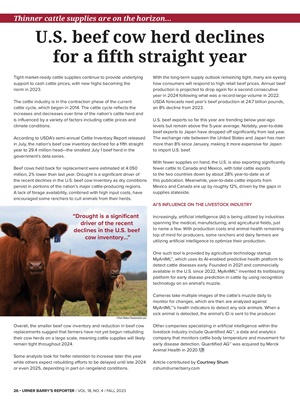
26 • URNER BARRY'S REPORTER / VOL. 18, NO. 4 / FALL 2023
Tight market-ready cattle supplies continue to provide underlying
support to cash cattle prices, with new highs becoming the
norm in 2023.
The cattle industry is in the contraction phase of the current
cattle cycle, which began in 2014. The cattle cycle reflects the
increases and decreases over time of the nation's cattle herd and
is influenced by a variety of factors including cattle prices and
climate conditions.
According to USDA's semi-annual Cattle Inventory Report released
in July, the nation's beef cow inventory declined for a fifth straight
year to 29.4 million head-the smallest July 1 beef herd in the
government's data series.
Beef cows held back for replacement were estimated at 4.050
million, 2% lower than last year. Drought is a significant driver of
the recent declines in the U.S. beef cow inventory as dry conditions
persist in portions of the nation's major cattle-producing regions.
A lack of forage availability, combined with high input costs, have
encouraged some ranchers to cull animals from their herds.
Overall, the smaller beef cow inventory and reduction in beef cow
replacements suggest that farmers have not yet begun rebuilding
their cow herds on a large scale, meaning cattle supplies will likely
remain tight throughout 2024.
Some analysts look for heifer retention to increase later this year
while others expect rebuilding efforts to be delayed until late 2024
or even 2025, depending in part on rangeland conditions.
With the long-term supply outlook remaining tight, many are eyeing
how consumers will respond to high retail beef prices. Annual beef
production is projected to drop again for a second consecutive
year in 2024 following what was a record-large volume in 2022.
USDA forecasts next year's beef production at 24.7 billion pounds,
an 8% decline from 2023.
U.S. beef exports so far this year are trending below year-ago
levels but remain above the 5-year average. Notably, year-to-date
beef exports to Japan have dropped off significantly from last year.
The exchange rate between the United States and Japan has risen
more than 8% since January, making it more expensive for Japan
to import U.S. beef.
With fewer supplies on hand, the U.S. is also exporting significantly
fewer cattle to Canada and Mexico, with total cattle exports
to the two countries down by about 28% year-to-date as of
this publication. Meanwhile, year-to-date cattle imports from
Mexico and Canada are up by roughly 12%, driven by the gaps in
supplies stateside.
AI'S INFLUENCE ON THE LIVESTOCK INDUSTRY
Increasingly, artificial intelligence (AI) is being utilized by industries
spanning the medical, manufacturing, and agricultural fields, just
to name a few. With production costs and animal health remaining
top of mind for producers, some ranchers and dairy farmers are
utilizing artificial intelligence to optimize their production.
One such tool is provided by agriculture technology startup
MyAnIML™, which uses its AI-enabled predictive health platform to
detect cattle diseases early. Founded in 2021 and commercially
available in the U.S. since 2022, MyAnIML™ invented its trailblazing
platform for early disease prediction in cattle by using recognition
technology on an animal's muzzle.
Cameras take multiple images of the cattle's muzzle daily to
monitor for changes, which are then are analyzed against
MyAnIML™'s health indicators to detect any sick animals. When a
sick animal is detected, the animal's ID is sent to the producer.
Other companies specializing in artificial intelligence within the
livestock industry include Quantified AG™, a data and analytics
company that monitors cattle body temperature and movement for
early disease detection. Quantified AG™ was acquired by Merck
Animal Health in 2020.
Article contributed by Courtney Shum
cshum@urnerbarry.com
Thinner cattle supplies are on the horizon…
U.S. beef cow herd declines
for a fifth straight year
©Pam Walker/Shutterstock.com
"Drought is a significant
driver of the recent
declines in the U.S. beef
cow inventory..."